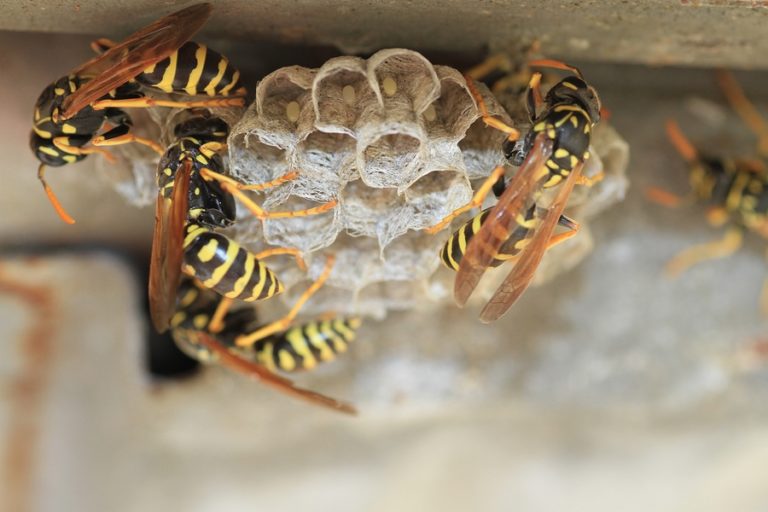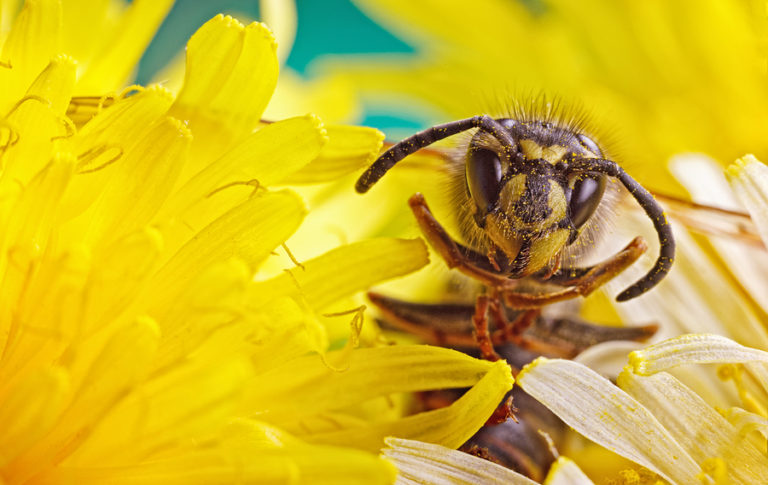Bee, Wasp and Hornet
Being stung by a wasp (yellow jacket), hornet or bee is a painful experience and can be life threatening to anyone who may be allergic to stings. However, it is possible to reduce these risks by taking sensible precautions when outdoors and ensuring that wasp nests or bee hives are properly managed.
How to Deter Bees and Wasps from nesting
Monitoring is key if you want to avoid problems with bees and wasps, especially if you know the area you are occupying has this pest problem. It is always easier to prevent a problem before it happens, rather than to wait for them to invade your home or garden.
Check for nests – Check your home and garden for nests, usually walnut or golf ball in size at the beginning – early small nests have fewer wasps and are easier to treat quickly. Look for nests in garages, sheds, cavity walls or under eaves.
Secure bins – Ensure outside bins have tightly fitting lids. Keep bins at a distance from doors and windows so wasps are not attracted to the contents.
Keep windows and doors shut – To prevent wasps entering inside your home.
Keep a safe distance – If you have spotted a nest, make sure you keep children and pets away from the area.
How to Deter Unwanted Bees
Seal potential entry points – Bees can enter any structure or object that contains a hole that is a quarter of an inch or larger.

Why Wasps Are Attracted to Your Home
Have you ever wondered why there are wasp nests near your home when it warms up outside? It’s worth knowing what these annoying pests look for when choosing a location for their nests. We’ll also give you a few tips on how to dissuade wasps from moving in around your home.
What a Wasp Thinks About When Searching for a Home
Humans look for a home that provides shelter from the elements and enough space to live comfortably. Unfortunately, wasps aren’t as selective. They’ll build their nests just about anywhere, so long as they have a sturdy, horizontal base to hang from.
Eaves, Ceilings and Overhangs
The favored nesting spots for wasps are eaves, porch ceilings and overhangs. They often choose a corner spot where the nest will be more protected.
Supply of Weathered Wood
Paper wasps, a very common species, get their names from the nests they construct. They build nests using wood fiber, therefore they need a construction resource near the nest. The queen wasp scrapes wood fiber from wood materials, and chews it to mix the fiber with her saliva, creating a paper pulp. She then spits it out at the desired build site to shape and create the nest. Gross, but very efficient for building.
Insect Food Supply
The one good quality wasps have is that they control the insect population by eating other bugs – placing them in the category of beneficial yard pests. The bad news is that if they decide your home is a good nesting location, that probably means there’s an ample food supply nearby.
Complete guide to Wasps by pest control specialist
So a wasp nest has settled around your property. What can you do keep those pests under control?
The wasp settles in little crevices around food sources such as ground holes, sheds and other organic matter. Wasp infestations occur every year during the warmer season and this time it just happened to be around your house, shed or other nearby location. Pests such as wasps are hostile and demonstrate a territorial behaviuor. They control their environment by defending their nests and food sources. Bakeries, restaurants and other food waste contributors create the ideal location for the queen to settle in and start their colony just as well as the compost in your garden!
Can I get rid of the wasp nest myself?
Although wasps are not known to spread any diseases they are known as a bother and a health threat not just to you but also for your neighbours and other people nearby. If wasps infestation persists in your area their colony will grow and expand their territory in search for additional food sources. As wasps use gaps, openings and cracks in various buildings it can be very difficult and dangerous to control jaspers and, and those pests will become hostile if you disturb their nests. Using commercially available products for wasp control without the protective equipment and the pest infestation knowledge will make it easy for the survivor wasps to relocate to a new location or persist and infest the area again in the near future.
Health Risks
Wasps often appear in the summer during the warmer season and can lead to life-threatening stings for people with allergies. Even especially during a mass attack of the wasps. The possible side effects include breathing difficulties, skin rashes, dizziness and a red spot where the wasp injects the venom. Despite the fact that a single sting does not usually lead to a serious health situation, a mass attack by the colony can lead to critical health conditions. Youngers are affected more often due to their tendency to get startled and panic at the sight of wasps, often becoming their victims. As wasps are active during the daytime, pest control specialist track their movement to locate the nests, estimate its size and devise a plan of action for efficient wasp removal.
Can I get rid of the beehive myself?
By attempting to remove the wasp nest alone you put yourself and your neighbourhood at risk. It is not as simple as using a smoke machine to lure bees out; doing so will only agitate the wasp. The wasps will become hostile and scatter. If the nest is destroyed the queen wasp will relocate and build a new colony nearby, so it’s advisable to hire a wasp control and pest infestation professional to reduce the risk of pests appearing again.
How long does it take for wasp nest fully develop?
There are multiple species of wasps with various life cycles, but there are a few common truths about all wasp nests. The hives life cycle is only one year which starts when the fertilized wasp queen creates the first layer of the nest. Each day the queen can lay between 200-300 larvae in the most optimal conditions for 24 consecutive days. Worker wasps seek nutrition for the colony, build the nest and protect against predators. With an average hive size of 30 wasp, the queen job continuously produces eggs to replace dying off wasp and create more future queens for future colonies. The wasp queens wake up in around April in the UK and colony’s grow throughout the summer until early October where future queens begin to hibernate and get fertilised by the male workers before they die off in the winter harsh conditions.
How Can I Find The Best Wasp Service Near Me?
Are you seeing flying insects around your property? Stinging insects such as paper wasps, mud wasps, hornets, and yellow jackets are most active in the summer months in New Jersey and Pennsylvania. Before you try to take care of wasp nest removal on your own, follow this guide to answer the common question of “Do I have wasps?”
Paper Wasps
Nest: Resembles an upside down umbrella with a honey comb pattern.
Insect: Brownish orange or yellow and black. 3-4 inches in length.
Behavior: Not inherently aggressive, but will sting if provoked.
Mud Wasps
Nest: Long, thin tubes OR looks like mud was thrown at a wall and splattered.
Insect: Defining feature is their thread-like waist. Can be blackish blue or have yellow and black stripes. Legs hang below the body when they fly.
Behavior: Not likely to sting as they are solitary wasps.
Hornets
Nest: Football-shaped. Large and grey.
Insect: Yellow and black or brownish red.
Behavior: Large populations live within each nest. They are aggressive and will sting if provoked.
Why do I have a wasp nest?
In spring and early summer, they return to create their nests and grow their colonies. Most wasps with the exception of yellow jackets build their nests high in trees, under lawn furniture, on playground equipment, attached to high up soffits, around windows, or attached to wooden decks. Once the nest is created, wasps begin to search for food to feed their nest. Your home has potential to provide an abundance of food sources such as smaller insects, nectar, vegetation, and fallen fruit. Although wasps are not known to eat wood, they will often use shavings to create their nest.
What to ask
If you have decided to take the next step in wasp nest removal, please ensure that the pest control company you choose has the necessary experience, knowledge, and tactics. Any reputable pest control company should be able to answer the following questions and provide comprehensive responses.

How Much Do Wasp Exterminators Cost? (A Simple Guide)
Did you know that wasps are beneficial to the environment? These brightly-colored insects are among nature’s most reliable pollinators, and they effectively function as predators to various garden pests at the same time.
But when threatened by our presence, wasps can deliver one of the most painful stings ever encountered by humans. Even worse, this sting contains certain proteins that can trigger severe allergic reactions.
One major factor wasps really care about when looking to build a nest is shade. So whether you like it or not, that tree in your garden, your porch, or even the eaves of your house make an ideal spot for this insect’s new home.
Have you ever seen a wasp nest?
Paper wasp nests look like round honeycombs with open cells. Its shape resembles that of an inverted umbrella and the texture of the material is almost identical to an actual piece of paper.
Why Make the Call?
Wasps are considered to be much more aggressive insects compared to bees. Even if you’re just trying to tackle normal daily chores outside your home, a particularly defensive wasp could get easily provoked into stinging you.